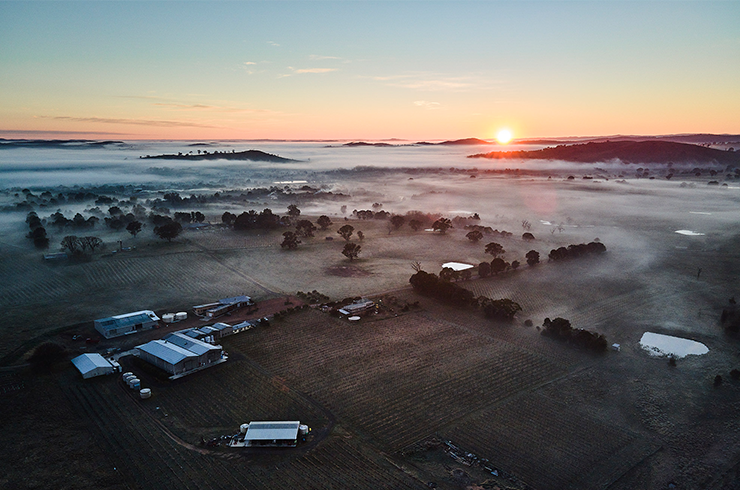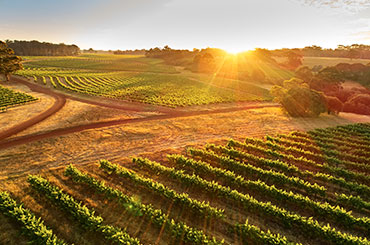How about a wine quiz? Nothing too taxing – just pick the grape variety that partners brilliantly with an array of foods. Go on, take a stab at it with these clues: it’s a wine that matches with roast chicken, but it’s not chardonnay. It’s perfect with chilli prawns and roast pork, but it’s not riesling. It’s textural, flavoursome and works wonders with smoked trout and garlicky mayonnaise. Fiano? Not even close. If served in a black glass, the wine could pass for a medium-framed red. If you’re on a French theme and thinking roussanne or perhaps blended with marsanne, you’d be spot on. Viognier fits too. Surprised? Maybe it’s time to reconsider these delicious Rhone whites.
When it comes to Australian-made examples of these varieties, especially the famed trio of marsanne, roussanne and viognier, they are at their best with food. They demand to be sipped alongside a meal because they complement and enhance one another so well. Given all that, it’s surprising they aren’t more appreciated. When did you last order a viognier for dinner?
Viognier
“We would like viognier to be more mainstream,” says Louisa Rose, chief winemaker at Yalumba, the company that has done more for the variety than any other in this country. “In the 2000s, viognier had its own section on wine lists and now it’s lumped in with ‘other whites’. That’s happened ever since pinot grigio and sauvignon blanc came along,” she says.
However, Louisa makes a more salient point. “It’s not a great aperitif style and that’s why it hasn’t worked in the by-the-glass section. The thing is, a glass of viognier without food doesn’t quite work. It’s a niche wine.”
According to the 2017 Australian and New Zealand Wine Industry Directory, data from the 2015 vintage shows that viognier plantings declined to 765 hectares from 1194 in 2014. The same trend is showing with marsanne, which is down to 163 hectares from 192 hectares in ’14. No information was recorded for roussanne, although it would hover around 100 hectares.
Yalumba remains steadfast in its devotion to viognier – a commitment that began in the 1970s when then chief viticulturist Peter Wall visited the French appellations of Cote-Rotie and Condrieu, the spiritual home of viognier. What’s extraordinary is the fact that this grape was so rare at the time, with about 14 hectares in existence. When Yalumba planted 1.2 hectares in Eden Valley in 1980, it became the first significant planting here. The site is the Vaughan vineyard, which today still provides the basis for The Virgilius, Yalumba’s flagship white.
Yet it is Louisa who has championed viognier like no other. Lots of trials over the years have led to learnings such as picking too early means no flavour, and that the grapes can over-ripen in a matter of days. The team also realised this low-acid wine is corrected if its phenolics are well handled because they give the wine richness, depth and texture, plus ageing potential. And its tannins are why Louisa has always described viognier as “a white wine for red wine drinkers”.
While Yalumba isn’t pursuing marsanne, the team has been nurturing roussanne since the late 2000s. Louisa says the work they have done on viognier has helped fast-track their commitment to roussanne. Despite all the trials with both varieties, each wine they produce is either 100 per cent viognier or roussanne – a point of difference to many blended styles.
When Louisa proffers a description of each, it’s easy to understand why she loves both styles. “Viognier is like walking through a stone fruit orchard. It has white nectarines and apricots, some white flowers, honeysuckle and orange blossom, and a bit of ginger and pepper. Whereas roussanne is a cottage garden full of tea roses, lavender and chamomile, near a sand dune so there’s a sea spray character,” she says.
Yalumba produces six viognier styles – four table wines, an eau de vie and a botrytised sweet wine. Seek out Samuel’s Garden Collection Viognier to appreciate the essence of the variety, while the roussanne under the same label is also a beauty.
Roussanne
Back in 2013, McLaren Vale’s Yangarra winemaker Peter Fraser made a trial roussanne using two 675-litre ceramic eggs. In one, the fruit was fermented on skins for 120 days and the other was made without skin contact. The final wine was a 60/40 blend of the two batches, with skin contact making up the majority. Peter took a risk in his approach to this wine, which is called Roux Beauté. “It has all that phenolic material and it’s such a textural white, so I wondered what would happen if you extracted all the tannins out of the skin and made it like a red wine, but managed the tannins, and enhanced the texture and flavour. It was scary making it, but fortunately it worked.”
Still using ceramic eggs, the 2015 Roux Beauté is again a 60/40 skin-contact dominant wine, this time spending 160 days on skins; it has morphed into an extraordinary wine. Roussanne often has aromas of herbal tea florals and poached pears, but it’s the texture and complexity that sets this wine apart. The Roux Beauté is one of two roussannes from Yangarra and both wines express their site as much as that wonderful varietal profile.
Peter admits his attraction to Rhone whites was based solely on grenache. “We believe grenache to be the pinnacle variety for the region. It’s not really scientific – we just thought if grenache does well, we should be looking at white varieties that grow with it [from its homeland]. So we delved into Chateauneuf-du-Pape.”
Under French wine law, the southern Rhone blend of Chateauneuf-du-Pape takes in a number of reds including grenache and allows six white varieties to be used: grenache gris and blanc, picardan, piquepoul blanc and gris, plus roussanne. “As roussanne was one of the more regal Chateauneuf whites, we thought we’d try that.” Initially, Peter took cuttings from nearby d’Arenberg and grafted them over in 2003. The first wine was made four years later.
Marsanne
If Yalumba leads the discussion on viognier, Tahbilk in central Victoria holds its own when it comes to marsanne. Although the winery grows roussanne and viognier, Tahbilk has the oldest and largest planting of marsanne in the world – six hectares were planted in 1927 and they now have a total of 26 hectares.
Fourth-generation winemaker Alister Purbrick says they made a decision in 1998 to harvest some of the 1927 plantings separately, pick it earlier to retain natural acidity and produce an aged wine. He has a rather poetic description of what age brings to the variety. “The ugly duckling emerges as a beautiful swan; a lovely, complex, textural wine with terrific minerality,” Alister says.
The inaugural release of the 1998 was in 2006. While screwcap helps, the freshness is astonishing, with the wine appearing years younger. The 2013 is available from this month.
Other Rhone whites
There are other Rhone whites that haven’t made a mark in Australia, largely because they haven’t been available. That’s changing now with recent plantings of bourboulenc, clairette, piquepoul blanc and grenache blanc. While vines are a few years away from producing, Tom and Nadege Carson in the Yarra Valley have planted grenache blanc at their Serrat vineyard. Henschke too. Whereas Yangarra has all four of these varieties planted, it’s the two hectares of grenache blanc that are exciting Peter Fraser right now. While waiting for these vines to produce, he is about to release a clairette and piquepoul blend through their cellar door, although this will be a one-off.
“I’m working on doing one white blend and the thought is that grenache blanc will take the lead, followed by clairette and roussanne with some salt and pepper added by piquepoul and bourboulenc,” Peter says. “While it’s important to keep a focus [on roussanne as the lead varietal], it’s great to have these bits and pieces to play with. It’s going to be an interesting journey.”
This article first featured in issue #39 of Halliday magazine, along with almost 20 of Australia’s best Rhone-style whites. Become a member to get every issue first.




